Formerly a common weed of grain fields, Agrostemma githago is becoming increasingly scarce, both in North America and in its native environs in Europe (R. Svensson and M. Wigren 1986). Mechanical screening of grain, which removes contaminants, and modern herbicides have more or less eliminated the plant from grain fields in the flora. The saponin-containing seeds, occurring as contaminants in grain, are poisonous to livestock, birds, and humans. This species is sometimes cultivated in flower gardens.
Annual herb with a stout taproot to 1 m tall
Stem: unbranched, thinly hairy.
Leaves: opposite, stalkless, 8 - 12 cm long, 0.5 - 1 cm wide, linear to narrowly lance-shaped with a pointed tip, midvein prominent.
Flowers: solitary at the ends of branches, reddish. Stalk upright, to 20 cm long. Stamens ten, exserted. Styles five, exserted.
Sepals: forming a tube with five linear to lance-shaped lobes. Tube green, around 1.5 cm long, elliptic to egg-shaped, coarsely ten-veined, and hairy. Lobes green, 2 - 4 cm long, longer than the tube, one-veined.
Petals: five, reddish (white on claw), 2 - 3 cm long, reverse lance-shaped with a notched, blunt tip.
Fruit: a dehiscent capsule (opening by five ascending teeth), 1.4 - 1.8 cm long, egg-shaped, many-seeded.
Similar species: Agrostemma githago has no similar species.
Flowering: May to July
Habitat and ecology: Introduced from Europe. A weed found in grain fields and waste places. It has also been found on railroad ballast. Not as common in the Chicago Region as it once was.
Occurence in the Chicago region: non-native
Notes: The seeds are poisonous to animals and humans.
Etymology: Agrostemma comes from the Greek words agros, meaning field, and stemma, meaning garland. Githago means "field garland."
Author: The Morton Arboretum
A weed mostly in grain fields and fallow fields and along roadsides and railroads. It has been reported from all parts of the state and occurs in every county. It was formerly much more common than it now is because improved threshing machines separate it from the grain. When I was a boy 60 years ago it was my annual task when the cockle was in bloom to take a pair of scissors and go through the wheatfield and cut the cockle and rye. The whole plant, and especially the seed, is more or less poisonous. Wheat screenings that contained any great amount of cockle seed, when fed to poultry, have sometimes proved fatal.
Stem to 1 m, thinly hairy; lvs linear or lanceolate, 8-12 cm נ5-10 mm; fls reddish, solitary at the ends of the branches, on pedicels to 2 dm; cal-tube 12-18 mm, elliptic-ovoid, the lobes 2-4 cm, lance-linear, acute or acuminate; pet 2-3 cm, oblanceolate, retuse; fr 14-18 mm; 2n=48. Native of Europe, widely established as a weed of grainfields and waste places, most abundant in the n. part of our range. July-Sept.
Gleason, Henry A. & Cronquist, Arthur J. 1991. Manual of vascular plants of northeastern United States and adjacent Canada. lxxv + 910 pp.
©The New York Botanical Garden. All rights reserved. Used by permission.










